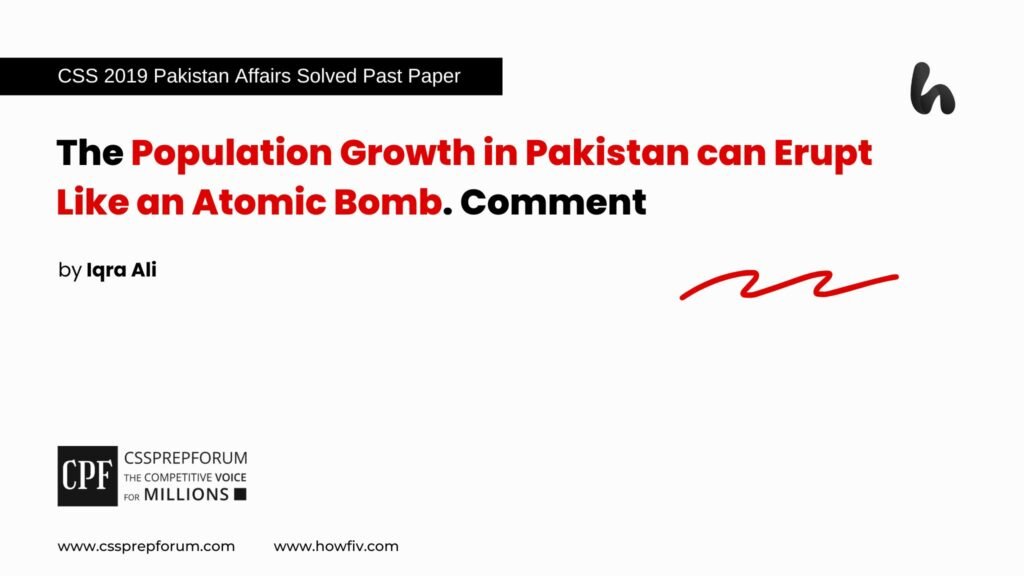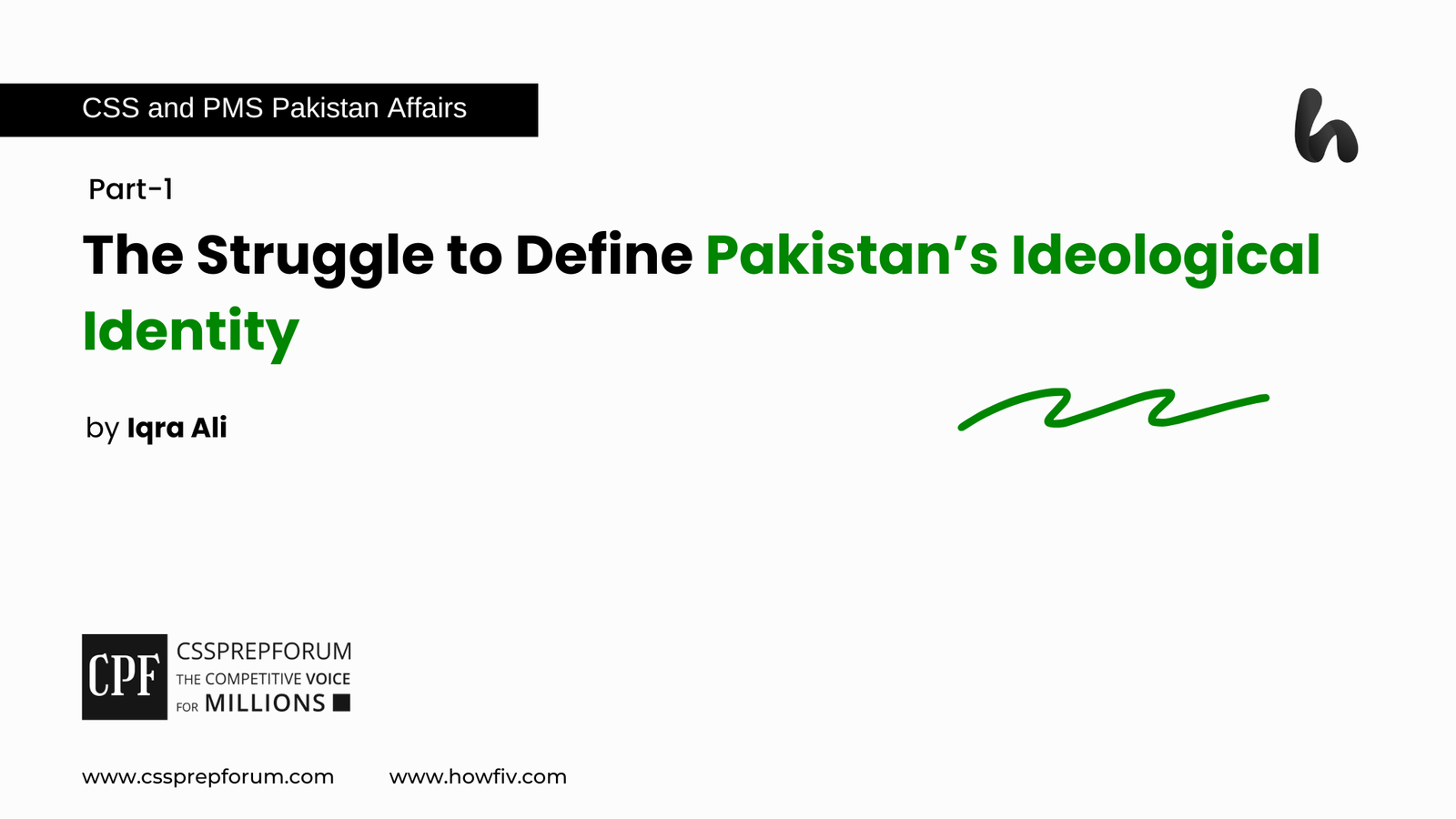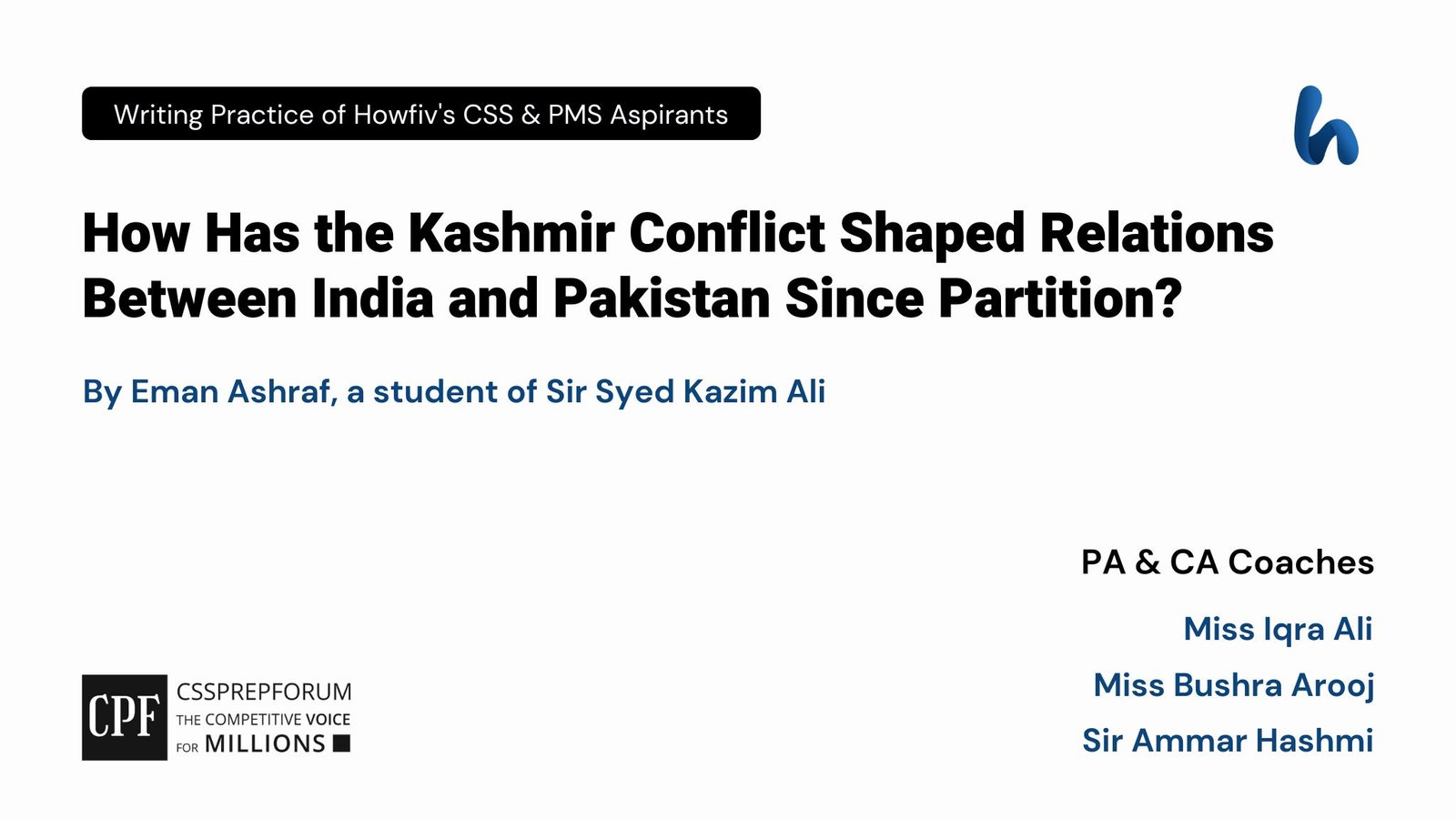CSS 2019 Solved Pakistan Affairs Past Papers | Population in Pakistan: an Atomic Bomb
The following question of CSS Pakistan Affairs 2019 is solved by Miss Iqra Ali, the best Pakistan Affairs Coach, on the guided pattern of Sir Syed Kazim Ali, which he taught to his students, scoring the highest marks in compulsory subjects for years. This solved past paper question is uploaded to help aspirants understand how to crack a topic or question, how to write relevantly, what coherence is, and how to include and connect ideas, opinions, and suggestions to score the maximum.

Question Breakdown
In this question, the examiner asked about how this growing population in Pakistan can be dangerous for its sustainability and prosperity. However, to gain high scores one must provide a comprehensive approach and analysis of this grave issue by giving recent statistics as well as its impacts that further manipulate the existing challenges faced by the country. In this question, after a brief introduction, the social, political, environmental, and administrative effects have been discussed.
Outline
1-Introduction
The growing population of any state can offer economic and demographic dividends to it. Still, Pakistan’s unrestrained growth rate threatens to act like an atomic bomb on its socio-economic infrastructure, exacerbating unemployment, resource scarcity, environmental degradation, and governance challenges.
2-A cursory glance at Pakistan’s population growth since its inception
- Pakistan’s population, reaching 241.9 million in 2024, is the fifth most populous world nation. The annual growth rate of 2.55% places the country among the fastest-growing countries.
3-How the uncontrolled population growth in Pakistan is a time bomb to the nation?
3.1-Economic restraints due to the rapid growth of the population
- ✓ Increasing ratio of unemployment
- According to Trading Economics, Pakistan’s current unemployment rate is 10% in youth, who make up over two-third of the population.
- ✓ Lower GDP per capita and informal employment
- The informal sector, which represents over 72% of employment, offers low wages and lacks social protection, exacerbating poverty and inequality
3.2-Social challenges linked to population growth
- ✓ Food insecurity and malnutrition
- According to the Global Hunger Index, Pakistan secured 99th ranking globally.
- ✓ Overburdened Healthcare system
- According to UNDP’s Human Development Report, Pakistan is classified as 164th indicating a worsening situation of human development.
- ✓ Education Crisis
- According to the Pakistan Bureau of Statistics, the country has a 66% literacy rate and has approximately 26 million out-of-school children, with girls disproportionately affected.
3.3-Environmental and resource depletion concerns
- ✓ Water scarcity
- According to UNDP, the country is currently facing critical water depletion and is ranked in the top 10 countries facing extreme water shortage among the world.
- ✓ Deforestation and urban expansion
- According to the 2023 census, the urban population now comprises over 37% of the total. Urban sprawl results in the loss of green spaces, intensifying climate risks, and ultimately biodiversity loss.
- ✓ Increased Carbon Emissions and Pollution
- According to statistics, the Air Quality Index of Lahore all over the year places the city among the worst globally which also highlights the climate risks due to population density.
3.4-Governance and administrative challenges
- ✓ Security concerns and social unrest
- Limited opportunities for youth create a risk of crime, extremism, social unrest, and radicalization that potentially destabilizes the country.
- ✓ Weak governance structure
- Exacerbated administrative difficulties, inefficient service delivery, and public dissatisfaction are the constraints in the way of a hitherto weedy governance system.
4-What can be pragmatic solutions and policy adaptations to cater to this bomb?
- ✓ To enhance family planning programs
- ✓ To invest in education and health
- ✓ To initiate environmental sustainability
- ✓ To induce economic reforms for job creation
- ✓ To empower and educate women
- ✓ To collaborate internationally at governmental levels
5-Conclusion

Answer to the Question
Introduction
Population growth, a double-edged sword, if managed properly, can be evidenced as a vibrant workforce for economic growth, innovations, and social developments, but if exploited by the states, it can erupt like an atomic bomb for the entire nation. Likewise, in the contemporary world, third-world countries, especially Pakistan, have been facing pressing challenges due to their population growth, resulting in severe socio-economic problems, environmental degradation, and political instability. With an augmentation of approximately 2% every year, the state’s population has been growing at a rapid pace adding millions of people. According to recent statistics, by 2050, Pakistan’s population will surpass the digit of 400 million, making it one of the world’s most populous countries. Certainly, this uncontrolled population growth threatens the social, economic, developmental, and political fabric of the state and hinders it from progressing races globally. Recently, the country has been enduring a triggered unemployment ratio, outpacing foreign debts, an overburdened health care system, an educational crisis, and above all, depletion of resources, which proves to be oil on fire. These unrestrained circumstances prerequisite the dire attention of the stakeholders and the harnessing of the potential of its energetic young generation to make them an economic powerhouse and rail the state to peace, progress, and prosperity.
A cursory glance at Pakistan’s population growth since inception
The country, since its inception, has experienced remarkable population growth, transforming from 32.5 million in 1950 to approximately 242 million people by 2024. This expansion makes the country among the fastest growing globally, influenced by high birth rates and cultural norms favouring large families. Moreover, the youth bulge under the age of 30 years, which was left unaddressed, has imprinted unexpected challenges to the nation’s economy, environment, infrastructure and widespread disruptions to the social fabric. Nowadays, the state has been ordeal through the exponential worsening of poverty, inflation, and potential collapse due to unmanaged and unrestrained population growth.
How the uncontrolled population growth in Pakistan is a time bomb to the nation?
A-Economic restraints due to the rapid growth of the population
- ✓ Increasing ratio of unemployment
Unfortunately, the great workforce has implications for the economy of the country; as the population expands continually, it exerts pressure on the system. It creates challenges in employment, income distribution, and overall economic productivity. The interconnected problems limit the country’s ability to sustain growth, improve living standards, and create a stable economy. Similarly, one of the most direct consequences of a growing populous is exaggeration in the unemployment rate among the youth. According to Trading Economics, in Pakistan, the current unemployment rate is 10% among youth, who make up over two-thirds of the population. The labour force increases every year as per the young demographic of the state, which directly over-stressed the incapability of the government to generate formal job opportunities for the bulk, leading to further economic unrest. Meanwhile, the constraints, including political instability, lack of infrastructure, and prevalence of red tape, have hindered the growth of small and medium-sized enterprises, which are mainly the significant employers.
- ✓ Lower GDP per capita and informal employment
Uncertainly, the youth bulge and its potential, which remained unaddressed for years, has ramified the dire circumstances of the state and derailed its progression. The growing population has outpaced the economic susceptibility, leading to stagnation in its GDP growth over the past few decades. Moreover, the crisis has raised the youth influence towards informal employment which further undermines the quality of life for millions of people and families. According to recent reports, the informal sector, which represents over 72% of employment, offers low wages and lacks social protection, additionally exacerbating the poverty level and social inequality. Furthermore, this jolted situation has compelled millions of people to spend their lives below the poverty line and jeopardized their bright futures.
B- Social challenges linked to population growth
- ✓ Food insecurity and malnutrition
Disastrously, as this issue intensifies in the country it creates social unrest and hurdles for the life of the common people. These challenges are deeply interconnected and contribute to wider societal issues, including food insecurity, inflation, health crisis, and education predicament. One of the serious issues, currently, Pakistan has been facing is food insecurity among the nation, as the population grows the availability of resources declines, and demand for food rises which in turn places extra pressure on the entire social system. According to the Global Hunger Index, Pakistan secured the 99th ranking globally, which demonstrates the situation of vulnerable communities of the state. Additionally, the non-availability of appropriate food to the population leads to access to less nutritious food and creates malnutrition among the poor people, which paves the way to a health crisis.
- ✓ Overburdened Healthcare system
Regrettably, the health care system of the country is severely overburdened due to this overgrowing population and limited access of common people to the standard health care system. Moreover, owing to these unbearable conditions doctor to patient ratio in the state is also below the levels set by the World Health Organization is 1:1000 and the country lies at 1:1300. Similarly, the state has a high mortality rate in the region due to understaffed and mismanaged public hospitals, with an estimated 186 per 100,000 births. According to UNDP’s Human Development Report, Pakistan is classified as 164th indicating the worsening situation of human development in the state. Additionally, malnutrition in the state has worsening conditions with 40% of children under five being stunted by it and approximately 17% being underweight, which highlights the system’s inability to meet basic facilities.
- ✓ Education Crisis
Along with it, the high intensity of population growth has also adverse the circumstances of education in the nation. The country faces a significant skill-deficient young generation which leads to unemployment and ultimately the stagnation of the economy. According to the Pakistan Bureau of Statistics, the country has a 66% literacy rate and has approximately 26 million out-of-school children, with girls disproportionately affected. Moreover, this education crisis and low literacy rate in the nation, especially among the women of the country, lead to a limited understanding of family planning. Notwithstanding, the cultural prohibitions towards planning the family as well stellar the conditions and making it lag socially, culturally, and economically.
C- Environmental and resource depletion concerns
- ✓ Water scarcity
For preservation and survival, every nation in the universe is highly reliant on the availability of its natural resources, with water being more essential. But, due to this tremendous populace, the country has been in a burgeoning situation of the dearth of water resources that impact it on social, political, and economic grounds and threaten the geological existence of the state. According to UNDP, the country is currently facing critical water depletion and is ranked in the top 10 countries facing extreme water shortage in the world. Where the state has tackled other socio-economic troubles due to this intense population growth, it has also faced the drastic transition from an abundance state at its inception to a scarce country at the moment. Nonetheless, the excessive annual water withdrawals by the public and its minimal storage capacity have exaggerated the situation of the state desperately requiring urgent policy intervention to avert a national water emergency.
- ✓ Deforestation and urban expansion
In addition, with the depletion of other natural resources, the country has also been facing a shortage of living spaces for the day-by-day increasing ratio of population that, as a result, turning the country into a hub for real estate expansion. The expanding cities encroach on forests, natural resources, and loss of green spaces which intensify the air and water pollution. Likewise, deforestation leads to biodiversity loss and climate risks, impacting long-term environmental sustainability. According to the 2023 census, the urban population now comprises over 37% of the total, and the deforestation rate is among the highest in Asia. This rapid urbanization represents a steady increase and places substantial pressure on infrastructure, housing, services, and, above all, valuation of the vulnerability of the country towards climate change and global warming.
- ✓ Increased Carbon Emissions and Pollution
Similarly, the high intensity of population growth in the country has also affected and contaminated the aerial environment with high carbon emissions. With increasing demands of industrialization, revenue generation, energy needs, and major reliance on fossil fuels the populace has ignored their majority contribution towards this day-by-day accelerative carbon emissions. According to the Global Air Quality Index (AQI) reports, Lahore is consistently among the most polluted cities globally because of its air quality, which also highlights the climate risks due to population density. Moreover, the country ranks as the 8th most vulnerable state to climate change around the world, which shows the deterioration of the environment including health issues regarding respiratory problems and cardiovascular tensions.
D- Governance and administrative challenges
- ✓ Security concerns and social unrest
This rapid populace growth is intricately interacted with several administrative and governance issues in the state. For instance, the crime rates in urban areas have exponentially expanded, constituting more security concerns in the nation. The high-density, under-resourced areas with a lack of opportunities are often breeding grounds for crimes and drive people towards illicit activities. On the same grounds, the risk of transgression, extremism, social unrest, and radicalization has been exploding, potentially destabilizing the country. According to recent data from the Citizen Police Liaison Committee (CPLC), the ratio of street crimes, such as theft, vandalism, and assault in the big cities, has surged during these years, leading to increased fatalities and casualties.
- ✓ Weak governance structure
Notwithstanding this high-intensity growth, the previously grieving and fragile governance system has now become more fatal owing to mishandling on administrative grounds. The local and provincial governments are generally understaffed, underfunded, and deficient in technical expertise that lacks to implement policies and effective service delivery to the public. Likewise, these exacerbated administrative difficulties and public dissatisfaction are the constraints in the way of a hitherto weedy governance system. According to the UN Human Development Index, Pakistan ranks 164th out of 193 globally, which reflects the long-standing issues that hinder the quality of life improvements. All these factors demonstrate the low institutional capacity, red tape, corruption, and incapability of the government sectors and the stakeholders and demand attention to improve the declivity.
What can be pragmatic solutions and policy adaptations to cater to this bomb?
Although, the country faces several challenges, the rapidly increasing population is a big query to solve to prevent this ticking bomb from blasting. But, as every dark cloud always has a silver lining and there is always a ray of light in the end of the darkest night, this ticking time bomb can be converted into a wonderful bouquet. Still, there is a ground for fair play and implementation the improved policies to steer the country on the rail of growth and prosperity. Currently, there is a dire need for policy implementation and pragmatic steps to follow to manage this population intensity, using the young generation as a potential force.
- First, make family planning services, such as contraceptives and reproduction health system awareness, accessible especially to underdeveloped and rural areas. In this manner, cultural sensitive education and media campaigns can help reduce societal and religious resistance.
- Second, investing in the education and health of common people can provide social awareness and low birth rates.
- Third, the initiative of environmental sustainability programs is necessary to make the youth of the state able to be an energetic workforce.
- Fourth, recently job creation and economic reforms with promotion of entrepreneurship are highly needed in the country to enable self-sufficiency and prosperity among citizens.
- The foremost and highly requisite reforms that are mandatory for the state are to empower and educate women about their economic role and social rights.
- Similarly, joint ventures for skill development and leveraging foreign expertise by making trans-governmental agreements to acquire technical assistance, financial support, and best practices for population management and sustainable development are becoming obligatory.
These policy implementations are essential for the country to mitigate the negative impacts of its population growth. Every step can offer a holistic approach to address social, political, economic, and environmental challenges for the stability of future generations.
Conclusion
Conclusively, this ongoing population growth can have catastrophic consequences like an atomic bomb for the country if not addressed and remains unchecked. There is a critical need for multidimensional and immediate strategies to harness its population as its asset rather than a liability. Family planning programs, bolstering educational developments, health care betterment, economic reforms to generate employment opportunities, and prioritized resource management are required for the nation’s uncertain trajectory.
CSS Solved Past Papers’ Essays
Looking for the last ten years of CSS and PMS Solved Essays and want to know how Sir Kazim’s students write and score the highest marks in the essays’ papers? Then, click on the CSS Solved Essays to start reading them.
CSS Solved Essays
CSS Solved General Science & Ability Past Papers
Want to read the last ten years’ General Science & Ability Solved Past Papers to learn how to attempt them and to score high? Let’s click on the link below to read them all freely. All past papers have been solved by Pakistan’s top CSS GSA coach having the highest score of their students.
General Science & Ability Solved Past Papers












